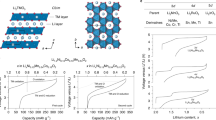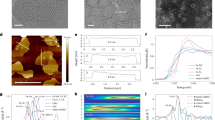Abstract
Batteries based on sodium superoxide and on potassium superoxide have recently been reported1,2,3. However, there have been no reports of a battery based on lithium superoxide (LiO2), despite much research4,5,6,7,8 into the lithium–oxygen (Li–O2) battery because of its potential high energy density. Several studies9,10,11,12,13,14,15,16 of Li–O2 batteries have found evidence of LiO2 being formed as one component of the discharge product along with lithium peroxide (Li2O2). In addition, theoretical calculations have indicated that some forms of LiO2 may have a long lifetime17. These studies also suggest that it might be possible to form LiO2 alone for use in a battery. However, solid LiO2 has been difficult to synthesize in pure form18 because it is thermodynamically unstable with respect to disproportionation, giving Li2O2 (refs 19, 20). Here we show that crystalline LiO2 can be stabilized in a Li–O2 battery by using a suitable graphene-based cathode. Various characterization techniques reveal no evidence for the presence of Li2O2. A novel templating growth mechanism involving the use of iridium nanoparticles on the cathode surface may be responsible for the growth of crystalline LiO2. Our results demonstrate that the LiO2 formed in the Li–O2 battery is stable enough for the battery to be repeatedly charged and discharged with a very low charge potential (about 3.2 volts). We anticipate that this discovery will lead to methods of synthesizing and stabilizing LiO2, which could open the way to high-energy-density batteries based on LiO2 as well as to other possible uses of this compound, such as oxygen storage.
This is a preview of subscription content, access via your institution
Access options
Subscribe to this journal
Receive 51 print issues and online access
$199.00 per year
only $3.90 per issue
Buy this article
- Purchase on Springer Link
- Instant access to full article PDF
Prices may be subject to local taxes which are calculated during checkout




Similar content being viewed by others
References
Hartmann, P. et al. A rechargeable room-temperature sodium superoxide (NaO2) battery. Nature Mater. 12, 228–232 (2012)
Hartmann, P. et al. A comprehensive study on the cell chemistry of the sodium superoxide (NaO2) battery. Phys. Chem. Chem. Phys. 15, 11661–11672 (2013)
Ren, X. & Wu, Y. A low-overpotential potassium–oxygen battery based on potassium superoxide. J. Am. Chem. Soc. 135, 2923–2926 (2013)
Lu, J. et al. A nanostructured cathode architecture for low charge overpotential in lithium-oxygen batteries. Nature Commun. 4, 2383 (2013)
Bruce, P. G., Freunberger, S. A., Hardwick, L. J. & Tarascon, J.-M. Li-O2 and Li-S batteries with high energy storage. Nature Mater. 11, 19–29 (2011)
Lu, J. et al. Aprotic and aqueous Li–O2 batteries. Chem. Rev. 114, 5611–5640 (2014)
Lu, J. et al. Effect of the size-selective silver clusters on lithium peroxide morphology in lithium–oxygen batteries. Nature Commun. 5, 4895 (2014)
Black, R., Lee, J.-H., Adams, B., Mims, C. A. & Nazar, L. F. The role of catalysts and peroxide oxidation in lithium–oxygen batteries. Angew. Chem. Int. Edn 52, 392–396 (2013)
Zhai, D. et al. Raman evidence for late stage disproportionation in a Li–O2 battery. J. Phys. Chem. Lett. 5, 2705–2710 (2014)
Zhai, D. et al. Disproportionation in Li–O2 batteries based on a large surface area carbon cathode. J. Am. Chem. Soc. 135, 15364–15372 (2013)
Yang, J. et al. Evidence for lithium superoxide-like species in the discharge product of a Li-O2 battery. Phys. Chem. Chem. Phys. 15, 3764–3771 (2013)
Gittleson, F. S., Ryu, W.-H. & Taylor, A. D. Operando observation of the gold-electrolyte interface in Li-O2 batteries. ACS Appl. Mater. Interfaces 6, 19017–19025 (2014)
Gittleson, F. S. et al. Raman spectroscopy in lithium-oxygen battery systems. ChemElectroChem 2, 1446–1457 (2015)
Olivares-Marín, M. et al. Spatial distributions of discharged products of lithium-oxygen batteries revealed by synchrotron X-ray transmission microscopy. Nano Lett. 15, 6932–6938 (2015)
Ryu, W.-H., Gittleson, F. S., Schwab, M., Goh, T. & Taylor, A. D. A mesoporous catalytic membrane architecture for lithium-oxygen battery systems. Nano Lett. 15, 434–441 (2015)
Schaltin, S., Vanhoutte, G., Wu, M., Bardé, F. & Fransaer, J. A QCM study of ORR-OER and an in situ study of a redox mediator in DMSO for Li-O2 batteries. Phys. Chem. Chem. Phys. 17, 12575–12586 (2015)
Das, U., Lau, K. C., Redfern, P. C. & Curtiss, L. A. Structure and stability of lithium superoxide clusters and relevance to Li–O2 batteries. J. Phys. Chem. Lett. 5, 813–819 (2014)
Sangster, J. & Pelton, A. D. The Li-O (lithium-oxygen) system. J. Phase Equilibria 13, 296–299 (1992)
Lau, K. C., Curtiss, L. A. & Greeley, J. Density functional investigation of the thermodynamic stability of lithium oxide bulk crystalline structures as a function of oxygen pressure. J. Phys. Chem. C 115, 23625–23633 (2011)
Kang, S., Mo, Y., Ong, S. P. & Ceder, G. A facile mechanism for recharging Li2O2 in Li–O2 batteries. Chem. Mater. 25, 3328–3336 (2013)
Hummers, W. S. & Offeman, R. E. Preparation of graphitic oxide. J. Am. Chem. Soc. 80, 1339 (1958)
Xu, Y., Sheng, K., Li, C. & Shi, G. Self-assembled graphene hydrogel via a one-step hydrothermal process. ACS Nano 4, 4324–4330 (2010)
Zhuravlev, Y. N. & Obolonskaya, O. S. Structure, mechanical stability, and chemical bond in alkali metal oxides. J. Struct. Chem. 51, 1005–1013 (2010)
Kumar, S., Selvaraj, C., Munichandraiah, N. & Scanlon, L. G. Gold nanoparticles anchored reduced graphene oxide as catalyst for oxygen electrode of rechargeable Li-O2 cells. RSC Adv. 3, 21706–21714 (2013)
Selvaraj, C., Kumar, S., Munichandraiah, N. & Scanlon, L. G. Reduced graphene oxide-polypyrrole composite as a catalyst for oxygen electrode of high rate rechargeable Li-O2 cells. J. Electrochem. Soc. 161, A554–A560 (2014)
Oh, S. H., Black, R., Pomerantseva, E., Lee, J.-H. & Nazar, L. F. Synthesis of a metallic mesoporous pyrochlore as a catalyst for lithium–O2 batteries. Nature Chem. 4, 1004–1010 (2012)
Ren, X., Zhang, S. S., Tran, D. T. & Read, J. Oxygen reduction reaction catalyst on lithium/air battery discharge performance. J. Mater. Chem. 21, 10118–10125 (2011)
Mitchell, R. R., Gallant, B. M., Shao-Horn, Y. & Thompson, C. V. Mechanisms of morphological evolution of Li2O2 particles during electrochemical growth. J. Phys. Chem. Lett. 4, 1060–1064 (2013)
Ottakam Thotiyl, M. M., Freunberger, S. A., Peng, Z. & Bruce, P. G. The carbon electrode in nonaqueous Li–O2 cells. J. Am. Chem. Soc. 135, 494–500 (2013)
Bikkarolla, S. K., Cumson, P., Joseph, P. & Papakonstantinou, P. Oxygen reduction reaction in electrochemically reduced graphene oxide. Faraday Discuss. 173, 415–428 (2014)
Antolini, E. Iridium as catalyst and cocatalyst for oxygen evolution/reduction in acidic polymer electrolyte membrane electrolyzers and fuel cells. ACS Catal. 4, 1426–1440 (2014)
Donkersloot, H. C. & Van Vucht, J. H. N. The crystal structure of IrLi, Ir3Li and LiRh3 . J. Less Common Met. 50, 279–282 (1976)
Pouget, E. M. et al. The initial stages of template-controlled CaCO3 formation revealed by cryo-TEM. Science 323, 1455–1458 (2009)
Ha, H.-W., Kim, I. Y., Hwang, S.-J. & Ruoff, R. S. One-pot synthesis of platinum nanoparticles embedded on reduced graphene oxide for oxygen reduction in methanol fuel cells. Electrochem. Solid-State Lett. 14, B70–B73 (2011)
Kresse, G. & Furthmüller, J. Efficiency of ab-initio total energy calculations for metals and semiconductors using a plane-wave basis set. Comput. Mater. Sci. 6, 15–50 (1996)
Kresse, G. & Joubert, D. From ultrasoft pseudopotentials to the projector augmented-wave method. Phys. Rev. B 59, 1758–1775 (1999)
Perdew, J. P., Burke, K. & Ernzerhof, M. Generalized Gradient Approximation made simple. Phys. Rev. Lett. 77, 3865–3868 (1996)
Blöchl, P. E. Projector augmented-wave method. Phys. Rev. B 50, 17953–17979 (1994)
Grimme, S. Semiempirical GGA-type density functional constructed with a long-range dispersion correction. J. Comput. Chem. 27, 1787–1799 (2006)
Giannozzi, P. et al. QUANTUM ESPRESSO: a modular and open-source software project for quantum simulations of materials. J. Phys. Condens. Matter 21, 395502 (2009)
Pickard, C. J. & Mauri, F. First-principles theory of the EPR g tensor in solids: defects in quartz. Phys. Rev. Lett. 88, 086403 (2002)
Ziegler, M., Rosenfeld, M., Kaenzig, W. & Fischer, P. Strukturuntersuchungen an Alkalihyperoxiden. Helvetica Physica Acta 49, 57–90 (1976)
Adrian, F. J., Cochran, E. L. & Bowers, V. A. ESR spectra and structures of NaSO2 and NaO2 . J. Chem. Phys. 59, 56–60 (1973)
Lindsay, D. M. & Garland, D. A. ESR spectra of matrix-isolated lithium superoxide. J. Phys. Chem. 91, 6158–6161 (1987)
Acknowledgements
This work was primarily supported by the US Department of Energy under contract DE-AC02-06CH11357 from the Vehicle Technologies Office, Department of Energy, Office of Energy Efficiency and Renewable Energy. We also acknowledge support from the Center for Electrochemical Energy Science (CEES), an Energy Frontier Research Center (EFRC) funded by the US Department of Energy, Office of Science, Office of Basic Energy Sciences (X-ray measurements and analysis). We also acknowledge support from the University of Illinois-Chicago Chancellor Proof of Concept Fund (DEMS measurements). We acknowledge the Conn Renewable Energy Research Center at the University of Louisville for providing the access to the DEMS equipment. We acknowledge grants of computer time through INCITE awards on the BlueGene/Q computer at Argonne National Laboratory and allocations on the CNM Carbon Cluster at Argonne National Laboratory and the LCRC Fusion Cluster at Argonne National Laboratory. Use of the Advanced Photon Source and the Electron Microscopy Center, Center for Nanoscale Materials was supported by the US Department of Energy, Office of Basic Energy Sciences, under contract no. DE-AC02-06CH11357. We acknowledge financial support from the Human Resources Development of the Korea Institute of Energy Technology Evaluation and Planning (KETEP) funded by the Korea government Ministry of Knowledge Economy (no. 20124010203310), and from the Basic Science Research Program (no. NRF-2014R1A2A1A11049801). We acknowledge C. Barile, R. Rooney, R. Assary and P. Redfern for discussions and help on the lithium superoxide reaction mechanism.
Author information
Authors and Affiliations
Contributions
J.L. and K.A. designed the experiments; Y.J.L., J.-B.P. and Y.S.J. synthesized the cathode materials; J.L., D.J.M. and J.W. performed and analysed the TEM imaging experiments; J.L., X.L., L.A.C. and Z.C. performed and analysed the X-ray measurements; J.L., X.L., Z.Z.F., D.Z. and H.-H.W. tested the cathode materials; M.A., A.S.-K. and B.K. performed the DEMS measurements, H.-H.W., X.L. and S.B. performed the Raman, NMR, EPR and FTIR experiments, K.C.L. and L.A.C. were responsible for the theoretical computations. L.A.C., K.A. and Y.-K.S. supervised the project; L.A.C., J.L. and K.A. wrote the paper. All of the authors discussed the results and reviewed the manuscript.
Corresponding authors
Ethics declarations
Competing interests
The authors declare no competing financial interests.
Additional information
Atomic coordinates for the LiO2 crystal structure from DFT can be obtained from the ICSD Database (http://www2.fiz-karlsruhe.de/icsd_home.html).
Supplementary information
Supplementary Information
This file contains Supplementary Figures 1-18, Supplementary Tables 1-3 and Supplementary References. (PDF 3650 kb)
Rights and permissions
About this article
Cite this article
Lu, J., Jung Lee, Y., Luo, X. et al. A lithium–oxygen battery based on lithium superoxide. Nature 529, 377–382 (2016). https://doi.org/10.1038/nature16484
Received:
Accepted:
Published:
Issue Date:
DOI: https://doi.org/10.1038/nature16484
This article is cited by
-
Machine learning-guided discovery of ionic polymer electrolytes for lithium metal batteries
Nature Communications (2023)
-
Predicting electronic structures at any length scale with machine learning
npj Computational Materials (2023)
-
Triarylmethyl cation redox mediators enhance Li–O2 battery discharge capacities
Nature Chemistry (2023)
-
Rational design of carbon-based electrocatalysts for enhancing redox reactions in rechargeable metal batteries
Nano Research (2023)
-
Coupling interface constructions of hollow Co-Mo mixed multiple oxidation states heterostructure for high-performance aprotic Li-O2 battery
Nano Research (2023)
Comments
By submitting a comment you agree to abide by our Terms and Community Guidelines. If you find something abusive or that does not comply with our terms or guidelines please flag it as inappropriate.



